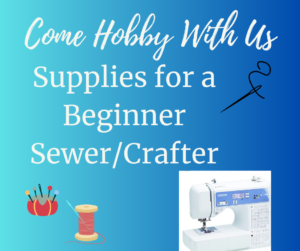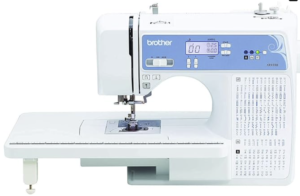We’ll talk fabrics below, but let’s discuss your cutting tools first.
Cutting Tools
- Dressmaker Shears: I recommend you buy the best dressmaker shears you can afford. I’ve had my current dressmaker shears for over 20 years and they still cut as wonderful as ever. I have Ginghers dressmaker shears in a special floral pattern that is no longer available. But the following link will show you the ones I currently recommend. Gingher 8″ Knife-edge Dressmaker Shears.
- Paper Scissors: Pick up a pair at the local dollar store and get this great package of two pairs of Westcott’s 8″Titanium Scissors on Amazon.
- Embroidery Scissors: You’ll need a pair of small scissors for clipping threads and making small cuts. Here’s my favorite. They have a sharp cut and are small enough to handle for those little jobs. Gingher’s Stork Embroidery Scissors.
- Ripper: You may have a small ripper that came with your machine. If you do, this is fine to start with. When you are ready for a more ergonomic one this is what I use. I have two. One for the sewing room and one next to my couch downstairs. Dritz Large Ergonomic Soft Grip Purple Seam Ripper.
- Rotary Cutter: A rotary cutter will help you cut very straight lines, which is harder to do with just your scissors. I have several sizes in my sewing room, but the attached is a good one when first supplying your craft room. I love the pink! OLFA Splash Rotary Cutter 45 mm Fairy Floss Pink
- Self-Healing Cutting Mat: You’ll use this along with your rotary cutter. I have a large one that fits atop a desk, but this one is a good brand and a convenient size. OLFA 18″ x 24″ Self Healing Rotary Cutting Mat.
- Rotary Rulers: You’ll need these to help you cut those straight lines. I recommend two of these.
- The first one is the Omnigrid 3 inch by 18 inch Angles ruler.
- The second one is great for cutting strips of fabric. It’s the June Tailor Shape Cut Plus Ruler. It can be a little pricey but add it as soon as you can if you are cutting a lot of strips of fabric. I couldn’t do without mine.
NOTIONS
- Thread: I suggest polyester to start or cotton thread if you want to make quilts. A 40-weight thread should handle most of your craft and quilting needs. I hesitate to recommend a thread bundle because the colors you will want will be personal. Choose what you like at a local store where you can see the true color. Hobby Lobby, JoAnn’s, and your local quilt shops will carry quality brands. Send me a comment if you have a specific question on your threads.
- Bobbins: Your machine will come with a few empty bobbins. I suggest that you get some extra ones or even purchase some pre-wound ones in black or white. When I buy pre-wound bobbins, I get 60 wt. as I do a lot of embroidery. I like a 40-wt thread on top and a 60-wt thread in the bobbin. These are the bobbins I buy for my sewing needs. HimaPro 144 PreWound Bobbins
- Pins: I like a medium-length pin with a round head. I seem to lose the flat-headed pins in the pin cushion and in the fabric. You should be able to find these at a local store, but here’s what I like: 600 Sewing Pin Straight Pin.
- Sewing Clips: I love using sewing clips. It saves me a lot of trouble when clip a binging on a quilt or when fabric wrapping a rope. You’ll find so many uses for these clips. MumCraft Multipurpose Sewing Clips with Tin Box.
- Hand Needles and Needle Threader: You will need some hand needles from time to time. I recommend an assortment pack. And if you have trouble threading a hand needle like me, use a simple needle threader. Here is a bundle pack with assorted needles and two needle threaders. 30/60 Pack Premium Sewing Needles for Hand Sewing Repair, 6 sized assorted Needle with 2 Threaders.
- Thimble: Thimbles will save your precious fingers and help you push a needle through layers of fabric. They come in various shapes and materials to cater to different preferences. Here are a few types:
- Metal Thimbles: Often made of brass or nickel, these provide a sturdy shield and are great for heavy-duty sewing.
- Leather Thimbles: Soft and pliable, these are perfect for a snug fit. They mold to your finger over time, offering a customized experience.
- Plastic Thimbles: Lightweight and affordable, plastic thimbles are ideal for beginners. They come in various colors and styles.
- Open-Sided Thimbles: Featuring an open top, these thimbles allow your fingertip to breathe while still offering protection. Great for warm climates or prolonged sewing sessions.
- Tailor’s Thimbles: These have an indentation on the top to control the needle better, making them a favorite among precision-sewing enthusiasts.
No matter which thimble you choose, the goal is to keep your fingers safe and stitching smoothly. Here’s a link to an assorted pack of thimbles. Mnuizu Sewing Thimble Set with Storage Box. It also comes with some hand needles, so you could save on those listed above. You might like different thimbles for different projects or find the kind that is your favorite.
- Measuring Tape: A measuring tape is like the GPS for your sewing projects – it guides you through accurate measurements, ensuring your creations fit like a dream. Whether you’re crafting garments, quilts, or home decor, having a reliable measuring tape is non-negotiable. It’s your go-to tool for sizing, marking hems, and checking proportions. I keep a retractable measuring tape and a dual-side measuring tape on hand. The dual-sided tape will feature inches on one side and centimeters on the other. Here’s a bundle where you can get both.
- Seam Gauge – I recommend two different seam gauges, but you can get both of them in one package here.
- Tape: I keep scotch tape and painter’s tape in my sewing supplies. I show you a little of this in my videos.
- Iron and Ironing board or pad: You may well already have an iron and ironing board. The iron I prefer is this one, but you can wait to get a really nice one. You might even want a wool pad to iron like this one.
- Pressing Cloths
-
- Fabric one: You will need a pressing cloth, but an old piece of fabric, a kitchen towel, or an extra pillowcase can work just as well.
- Teflon One: Use these when ironing heat transfer and interfacing on the back of fabric token your iron or ironing borard from getting sticky. Here’s three in one package.
-
- Fabric Markers: You are going to need a way to mark placement many times in your sewing. Here are some of the choices on the market: Tailors Chalk, Heat Erasable Marking Pen, Sewing Fabric Pencils, Water soluble markers, and Air dry markers. What I like best are the Tailors Chalk and the Chalk pencils. But even ordinary chalk you can get at the dollar store works. The Tailors Chalk just washes out better. So, in just starting out here’s a variety pack of markers. Tailors Chalk, Sewing Fabric Chalk and Fabric Markers. Please note I don’t use heat transfer markers very often. I tell you why in my video.
- PurpleThang This little gadget is a versatile powerhouse. Shaped like a purple mini spatula, it might seem unassuming, but oh, the wonders it can do! That Purple Thang is perfect for guiding and turning fabric, poking out corners, and pushing seams without risking your fingers. It’s like having an extra set of precise and gentle hands for your sewing projects. Get two in this package,
- Tweezers Let’a shine a spotlight on a must-have tool in every sewing enthusiast’s arsenal – the Stainless Steel Tweezers with Curved Serrated Tip! 🧵✨.The curved serrated tips make them perfect for intricate tasks. Need to grab that tiny thread buried in your sewing machine? These tweezers have got you covered. Whether you’re doing detailed embroidery work, fixing delicate fabrics, or simply handling small embellishments, these tweezers are your secret weapon for precision. And guess what? You get not one but two in a set! Check these out.
FABRICS AND INTERFACING
- Fabrics I talk about some fabrics on the video, plus where you might find some inexpensive but good fabrics. Even free fabric.!!
- Interfacing: I don’t know that you will need interfacings in the beginning. This will be more project-specific but…I do recommend if you intend to do some applique and various crafts you get some Iron-On-Backing, which is the next item in our list.
- Iron-on-Backing: Let’s talk about a game-changer in the world of fabric crafting – Heat n Bond! 🧵✨ This magical adhesive is a go-to for adding strength and stability to your sewing projects. It’s like giving your fabrics a confidence boost! I demonstrate how to use this in my video that goes along with this post..Now, let’s explore the varieties of Heat n Bond that can level up your crafting game:
- Lite Heat n Bond: Ideal for lightweight fabrics, this version provides a strong bond without adding bulk, making it perfect for delicate projects like appliqué. If you only add one Heat n Bond to get started, this is the one. Heat N Bond Iron Adhesive Value Pack.
- Ultra Hold Heat n Bond: When you need a bond that’s as tough as nails, this variety is your best friend. It’s designed for heavyweight fabrics and ensures a durable and long-lasting connection.
- Feather Lite Heat n Bond: For projects that require a barely-there bond, Feather Lite is the answer. It provides a gentle hold without compromising the flexibility of your fabrics.
- Heat n Bond Hem Tape: Say goodbye to sewing hems! This convenient tape is perfect for quick and easy hemming, giving your garments a polished finish.
- Heat n Bond Fusible Interfacing: When you want to add structure and stability to your fabrics, fusible interfacing comes to the rescue. It’s available in various weights to suit different project needs.
EXTRAS
- Buttons
- Zippers
- Small Vacuum
- Pipe Cleaners
- Glue gun and glue sticks
- Snaps/Hook & Eyes / Closures
More Information on the YouTube video.
Click Here
You have to scroll down to leave a comment.
 A friend of mine wants to start crafting with a sewing machine and wants to know the basic supplies she needs to have on hand. So…..today, we’re diving into the wonderful world of sewing supplies for craft-related projects.
A friend of mine wants to start crafting with a sewing machine and wants to know the basic supplies she needs to have on hand. So…..today, we’re diving into the wonderful world of sewing supplies for craft-related projects. Brother XP9500. It has 65 built-in stitches and is computerized as a sewing and quilting machine. It comes with a nice LCD Display, a wide table, and includes 8 different presser feet.
Brother XP9500. It has 65 built-in stitches and is computerized as a sewing and quilting machine. It comes with a nice LCD Display, a wide table, and includes 8 different presser feet.
Nice list of supplies. Thanks.
Great list Judy. I especially like the sewing clips and tweezers. Two of my go-to’s that I didn’t use to know about. I don’t think they had the little clips when I took home-ec 50 years ago!
I’m glad you liked the post on supplies. I should have a link for the video added by tomorrow.